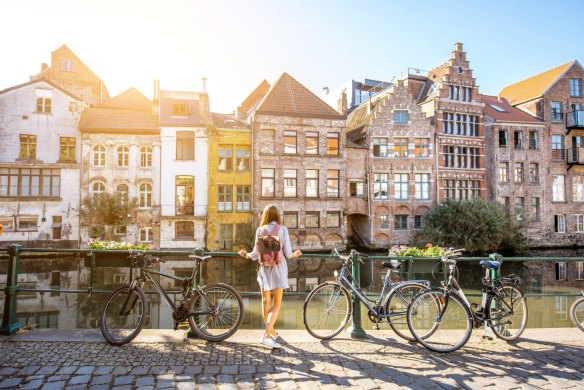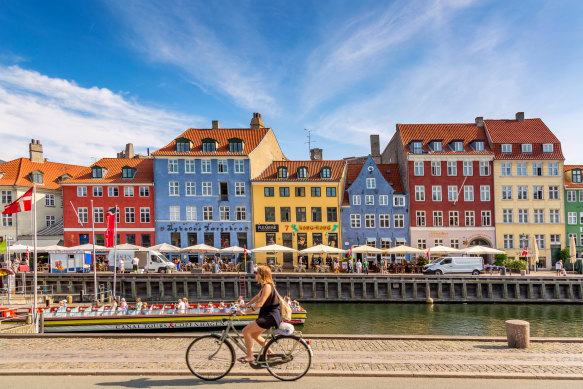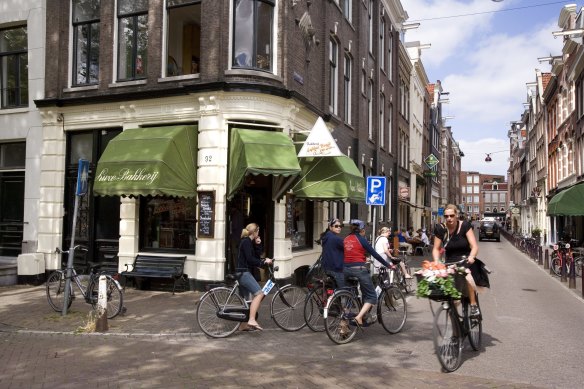How cyclists are taking over Europe’s cities, and why it’s a good thing
By Gavin Haines

Ghent, in Belgium, has banned through traffic. Credit: iStock
Who saw that coming? Like a cyclist with no lights on, the conspiracy around 15-minute cities has caught us by surprise. A socialist plot, they say. A “climate lockdown”. It goes to show that you can whip up a conspiracy theory about anything these days.
For those who missed the furore, let me fill you in on the mundane planning concept that nearly melted the internet. It centres around an idea that’s gaining traction among policymakers, but will seem passe to most people over 40: that urbanites should have most of their daily needs met within a 15-minute walk or cycle of their homes. You know, like the old days, when there was a parade of shops in every neighbourhood. Schools and doctors on the doorstep. A post office. Pubs.
What happened to all that, you may wonder. Cars, mostly; and the subsequent rise of out-of-town supermarkets and housing estates. It probably seemed like a good idea at the time – progressive even – but as the world realises the old ways weren’t so bad after all, the 15-minute city is having a moment, and urban landscapes are being tweaked to make walking and cycling more attractive (and, yes, driving less appealing).
Slowly, people are getting on board. As the world realises that car-centric planning made our cities uglier, more dangerous, dirtier and slower, an urban cycling renaissance is sweeping the globe – and no one is benefitting more greatly than the humble tourist.
No longer must we navigate complex foreign metro systems and indecipherable ticket machines, or work out how many times to punch our tokens on the bus, or pay through the nose because our taxi driver’s meter is, mysteriously, kaput. Now, docks with rows of gleaming bikes for hire dot Europe’s major cities, while up-market hotels offer trendy vintage bikes with wicker baskets for ease of gallivanting.
Savvy tourists pedal freely from site to site, beholden to no timetable, no longer wasting precious hours sitting in the back of gridlocked Ubers, soaking in the rhythm of the streets, rather than inching along in a tunnel beneath them. Sure, it rains, but as the saying goes, there’s no such thing as bad weather, just the wrong clothes – so pack accordingly.

Copenhagen has long led the way in terms of cycling accessibility.Credit: iStock
Hop across the North Sea for the weekend, to the Netherlands and Denmark, and you’ll find they’ve been doing all this for decades, realising that motor-oriented city planning was a dead-end way back in the post-war years as car ownership surged.
Emerging mostly intact from the war, their winsome old cities simply weren’t suitable for motor vehicles. And so, while the world raced to put smut-belching cars at the heart of urban planning, the Danes and Dutch banked on bikes. It paid off, literally – according to the Cycling Embassy of Denmark, Copenhagen’s strategy has resulted in one million fewer sick days each year, saving the local economy €1bn ($A1.61bn) annually. Now the rest of the world is playing catch up, and electric bikes are turbocharging the transition.
One city making strides is Paris. A decade ago, no tourist would have dared take life in their hands to cycle across the French capital – these days, it’s the best way to get from gallery to bistro and beyond. There are more than 600 miles of cycle lanes (with more on the way), various bike hire schemes to choose from, and entire roads reserved for cycling. It’s all part of mayor Anne Hidalgo’s plan to turn Paris into a “cycle city”, which appears to be working. In 2019 alone, the number of bike journeys made in the city jumped by 66 per cent.
London has seen a similar transformation. Cycle superhighways now crisscross the city, and in the suburbs, it’s common to see kids being shuttled to and from school in cargo bikes. With constant traffic jams and an expensive transport network, for many Londoners and an increasing number of tourists, Lime bikes – the electric cycles you can leave almost anywhere, and hire via the Uber app – are now the easiest way to get from A to B.
An estimated 800,000 journeys a day are now made by bike in the English capital. A recent report by Transport for London suggests that cycle trips are up by a quarter compared to pre-pandemic levels, with an 82 per cent rise at the weekends. And the number of people killed on the city’s roads fell to an all-time low in 2021.
It’s not just the West embracing bikes, and when the likes of oil-rich Dubai dons the Lycra, you know things are getting serious. As ever, the emirate is not doing things by halves. In a bid to transform Dubai into a 20-minute city (cue uproar), the authorities plan to build a tubular 93km cycle lane and walkway that will be air-conditioned, lined with plants and powered by renewables. Renders suggest it’ll be like cycling through the Eden project, and the proposed route takes in most of the major tourist hubs, including the Marina, Downtown and the Dubai Frame.
Some cities have taken a more combative approach. Ghent, in Belgium, banned through traffic, leading one irate shopkeeper to send the then-mayor Frank Beke a bullet in the post. But, rather than adversely impact trade, as was feared, the scheme did the opposite and apparently slowed the rate of shop closures, all while getting more people on their bikes. Birmingham is now looking to copy the concept.
Bogota’s car-free Sundays, meanwhile, have brought benefits beyond boring economics. According to a study by the American Journal of Public Health, people feel considerably safer on Sundays because of the initiative. “The city just changes,” Bogota-born cycle advocate, Marcela Guerrero Casas, told me. “From the way it sounds, to the way people behave.”

Amsterdam is famed for its bike-friendliness.Credit: Getty Images
There have been some bumps in the road, of course, but for every problem, a solution. Amsterdam’s response to a lack of cycle storage at Centraal Station? A sleek underwater bike garage festooned with art. A lack of space for bike lanes? In Auckland, a “cycle skyway” running above an often congested motorway, and in Belgium’s Limburg, a treetop cycle route which takes riders through the forest canopy.
Forget self-driving cars, the future of urban transport was here all along. On your next city break, why not get on your bike and join the revolution?
How to do it
If your hotel doesn’t offer complimentary bike hire, your best bet is to use pay-to-ride options – like London’s Santander Cycles, Barcelona’s Bicing, Brussels Villo! and Montreal’s BIXI, visit a bike rental shop – or even take an organised tour of the city by bike, such as the three-hour Amsterdam tour offered by Mike’s Bikes ($55 per adult).
If you’d like to cycle between cities too, opt for a city-to-city cycle holiday like Cycle Tours’ 15-day Bruges to Paris trip, which costs from $3247 per person, including accommodation, 12 dinners, 12 lunches, a guide and insurance.
The Telegraph, London
Sign up for the Traveller Deals newsletter
Get exclusive travel deals delivered straight to your inbox. Sign up now.